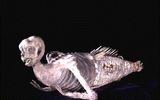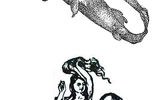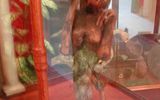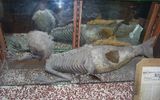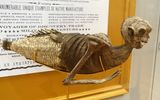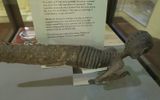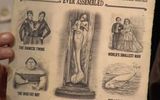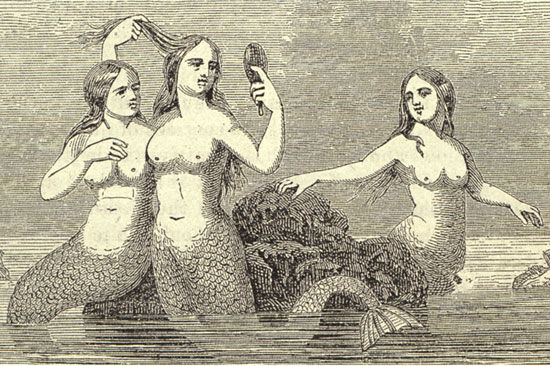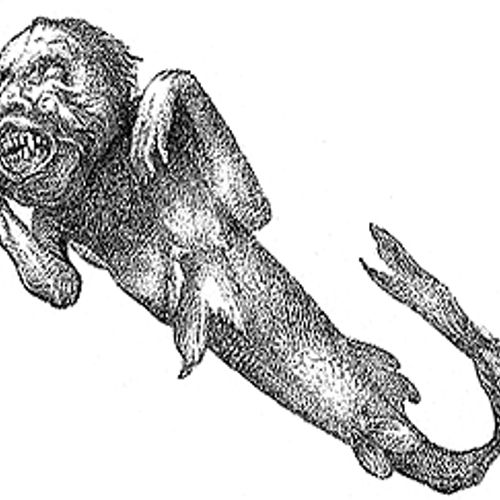
| Added | Thu, 07/05/2020 |
| Источники | П. Т. Барнум, «Жизнь П. Т. Барнума», 1855 год (The Life of P. T. Barnum)
|
| Версии |
"The Fiji sea virgin", "Fiji mermaid" or "mermaid of the Fiji Islands" – the common name popular in nineteenth century exhibit all kinds of wandering "exhibitions of curiosities" and street shows.
Most likely, the object represented by the torso and head of a small monkey, United with the back of a large fish. At exhibitions this exhibit was represented as a mummified body of a real being, called in the folklore of the sea maid (eng. "mermaid"), and this name so it stuck. The term "Fijian" in the title got through to Phineas Barnum, one of the major figures of American show business in the nineteenth century with demonstrations of the "sea virgin" the audience actively promoted the theory that such beings are caught off the coast of Fiji, which in those days was virtually unknown to the General population of USA and Europe. Interestingly, Barnum, which is showing the mummy of the mermaid, in promotional materials portrayed her alive.
There are many versions of the origin of this exhibit, which appear in the articles, collections and books. Give a few of the most common, for example – this:
According to legend, the exhibit Barnum (later called the "Fiji mermaid") was caught by a sailor in the waters of Fiji. But this sailor-lucky man was none other than Barnum's accomplice, in fact, the mermaid was hand-made stuffed – a hybrid of monkey and fish, densely covered with papier-mache. Despite the hype, the show Barnum was a huge success and was the cause of the present explosion of popularity of such mysterious items. A lot of them walked around the world with mobile exhibitions. Even today, you can find mummified mermaids, different materials of manufacture and places of origin from Japanese temples to the shops for ancient artifacts.
Another option:
In civilization the Scarecrow fell from the hands of captain Samuel IDs, which the Dutch West India cheated the merchant, saying that "mermaid" was caught in his eyes somewhere off the coast of Japan. The merchant demanded for the monster so much that simpleton the IDs had to sell his own ship. The money remained on the ticket to England, but before boarding the ship, the Scarecrow seized customs. Then returned, but it was too late. On the last coin the captain gave an ad in the newspaper about the greatest discoveries of all time. Then there were the people that bought the IDs of his ship, and demanded the money back. The final blow to the spirit of IDs caused by local naturalists, who viewed the mermaid and said that it was a fake.
Third version:
In mid-July, 1842, an English gentleman named Dr. John. Griffin (J Griffin Dr), who was a member of the British Lyceum of Natural History (British Lyceum of Natural History), arrived in new York, bringing a real mermaid, which was supposedly caught near the Fiji Islands in the South Pacific ocean.
Shortly after this, the showman p. T. Barnum (P T Barnum) tried to convince Dr. Griffin to allow him to put a mermaid in his Museum. Dr. Griffin agreed to exhibit it for a week at concert hall on Broadway. Barnum circulated throughout the city of ten thousand copies of the brochures with the image of seductive mermaids. In August 1842, a huge crowd gathered to watch the exhibition.
Throughout this time the deception of the public was twofold. First, Dr. Griffin was a fraud. He was not an English gentleman. There was no British Lyceum of Natural History. The real name of Griffin was Levi Lyman (Lyman Levi). He was an associate of p. T. Barnum, and the whole story was invented in order to give the "mermaid" patina of scientific respectability. Second, the very famous "mermaid" was made from half of a skeleton of a monkey (torso and head) which were sewn to the back half of the fish, and then covered with papier-mache, and Barnum knew it.
Fourth option:
In 1842, Moses Kimball, curator of the Boston Museum, for a pittance, bought a stuffed animal from an unknown Englishman and immediately sent a letter to his enterprising friend to Phineas Barnum. He took the creature in the lease, dubbed "the Fiji mermaid" and spread the buzz around the new York "scientific" articles about the phenomenon in the Newspapers was accompanied by an engraving with the image of a beautiful mermaid with bare Breasts. The promised exhibition was looking forward to thousands of the curious. The opening invited Barnum, doctor of biology announced a nightmarish mermaid real. No scientists, this "doctor", of course, was not.
The most authentic history of "the Fiji sea Virgo" listed in the book "Life of PT Barnum" written by himself and published in 1855. For example, here is given in text advertising one of the shows Barnum, from which you can understand in what ways he represented the "mermaid" as a miracle of nature:
The public is respectfully informed that, in accordance with numerous and urgent requests scholars of gentlemen in this city, Mr. George. Griffin, a researcher of the mermaid, recently arrived from Pernambuco, California, agreed to demonstrate one of them to the public for only one week! For this purpose he rented a spacious saloon known as Concert hall, at 404 Broadway, which will open on Monday, 8 August 1842, and closes on Saturday 13 August.
This animal was caught near the Fiji Islands, and purchased for a large sum by the current owner for "Lyceum of natural history" ("Lyceum of Natural History") in London and exhibited for this short period more for the gratification of the public than for gain.
The owner for several years engaged in collecting wonderful specimens of natural history in different parts of the world. His famous designs: Ornothing (THE ORNITHORHINCHUS) from New Holland connecting link between the seal and the duck. Flying fish (THE FLYING FISH), two different types, one of the Gulf stream and the other from the West Indies. This animal obviously connects the bird with the fish. Veloplasty snake (THE PADDLE-TAIL SNAKE), combining reptile and fish. Proteus Sanguinus (THE PROTEUS SANGUIHUS) – animal from the Australian underground grotto. All of them together with other animals forming connecting links in the great chain of animated nature.
Tickets at 25 cents each.
In the following passage from autobiography, Barnum describes how he used the employee depicting a scientist, and used the credulity of the popular press to perpetrate the hoax:
In the early summer of 1842, Moses Kimball (Moses Kimball), Esq, the popular owner of the Boston Museum, came to new York and showed me what was supposedly a mermaid. He said that he bought it from a sailor whose father, while in 1817 in Calcutta as captain of the Boston ship, purchased the Scarecrow, believing that this preserved example of a real mermaid, obtained, as he was assured, from Japanese sailors.
Not doubting that it will be as amazing for others as for himself, he took $ 6,000 of the money of a ship to buy it, and then went with him to London.
There is a Scarecrow not meet expectations, and the sailor returned to Boston. Still believing that his purchase was a genuine mummy of the animal and therefore very valuable, he preserved it with great care, do not hesitate in the cost of insurance, although again took on the responsibilities of the captain of the ship under the guidance of his former employers to reimburse the amount taken for the purchase of a mermaid. He died, having no other property, and his only son and heir, who low rate the purchase of your father, sold it to Mr. Kimball, who brought her to new York for my examination.
That was the story. Did not trust myself in such matters, I asked the opinion of my friend the naturalist about the authenticity of the animal. He replied that he could not understand how it was made, because he never knew a monkey with such peculiar teeth, arms, etc., and he also didn't fish with such peculiar fins.
- "Then why do you think he made?" - I asked.
"Because I don't believe in mermaids" - said the naturalist.
- "This is not the reason," said I, "and so I believe in mermaid and I'd buy it."
It was the easiest part of the experiment. How to change a General distrust of the existence of mermaids, and to awaken curiosity to see and examine the specimen, has now become a critical issue. Need to resort to some extraordinary means, and I have not found a better way than "run the ball some distance from the centre of gravity".
At the time, in the newspaper "new York Herald" (New York Herald) there was a message, dated and mailed from Montgomery (Alabama), information about business, trade, the crops, political gossip, etc., and also a paragraph about a certain Dr. Griffin from "the Lyceum of natural history" ("Lyceum of Natural History") in London, which had a wonderful exhibit that was nothing short of a real mermaid caught near the Fiji Islands and surviving in China where the doctor bought it for School.
After a week or ten days in another new York newspaper published a letter of a similar nature, dated and mailed from Charleston (South Carolina), which, of course, differed on the subject of local news.
This was followed by the third letter, dated and mailed from the city of Washington, published in another new York newspaper. In this letter the hope was expressed that the editors of the Empire city will be asked about the extraordinary exhibit of Dr. Griffin.
A few days after the publication of this thrice-repeated announcement, Mr. Lyman (who was my employee in the case of Joyce Heth) was duly registered in one of the main hotels in Philadelphia as Dr. Griffin of Pernambuco. His gentlemanly manners earned him a good reputation in a few days, and when one day he paid the bill, ready to leave for new York the next day, he thanked the landlord for special attention and courtesy.
"If you go into my room,' said Lyman in the form of a Griffin, I will allow you to see something that will surprise you".
Then the owner demonstrated the most extraordinary exhibit in the world – a mermaid.
... The result of this demonstration can be seen in the editorial columns published in a day or two Philadelphia Newspapers. Suffice it to say that the plan worked perfectly, and the Philadelphia press helped press, new York, to awaken a wide and growing curiosity in wanting to see a mermaid.
I can also confess that those three communications from the South were written by me and sent to my friends with instructions to send them by mail, each your date. This fact and also genuine postage stamps on letters, did much to prevent suspicion of fraud, and new York editors thus unconsciously contributed to my arrangements for bringing the mermaid to the public.
Thus, Barnum did not conceal his fraud. But in his book he talks about how and what was made this famous exhibit. Most sources agree that the "human" part of the mermaid consisted of a small body (or immature) of the monkey, and the tail belonged to a large salmon.
The prominence of this "mermaid" became the cause of many similar forgeries, some of which still can be found in collections of different museums.
The end of history, the "Fiji mermaid" is not exactly known. According to one version, it was destroyed in 1865 by fire, which burned the Barnum Museum (this version is considered unlikely, because while "mermaid" was exhibited at the Boston Museum Kimball). According to another version, the caller from the experts was more credible, "the mermaid" was destroyed much later, when in early 1880-ies of the burned Museum Kimball.
Translated by «Yandex.Translator»
"Fijian Sea Maiden", "Fijian Mermaid" or "Mermaid from the Fiji Islands" is the common name of a popular exhibit in the XIX century of all kinds of wandering "exhibitions of curiosities" and street shows. The term "Fijian" got into the name thanks to Phineas Barnum, one of the largest figures of American show business of the XIX century, who, during demonstrations of the "sea maiden" to the public, actively promoted the version that such creatures were caught off the coast of Fiji, which at that time were practically unknown to the ordinary population of the USA and Europe.
In the book "The Life of F. T. Barnum", written by himself and published in 1855, it is indicated that the "Fijian Sea Maiden" is a hoax
Log in or register to post comments
